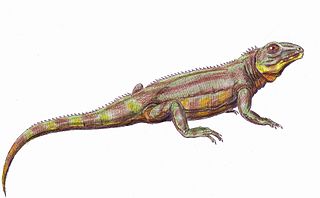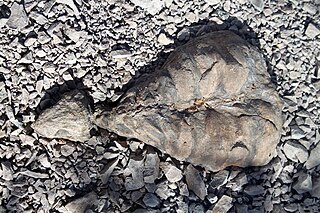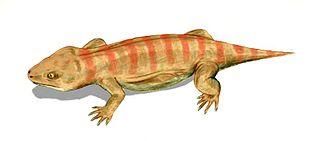
Bolosauridae is an extinct family of ankyramorph parareptiles known from the latest Carboniferous (Gzhelian) or earliest Permian (Asselian) to the early Guadalupian epoch of North America, China, Germany, Russia and France. The bolosaurids were unusual for their time period by being bipedal, the oldest known tetrapods to have been so. Their teeth suggest that they were herbivores. The bolosaurids were a rare group and died out without any known descendants. The following cladogram shows the phylogenetic position of the Bolosauridae, from Johannes Müller, Jin-Ling Li and Robert R. Reisz, 2008.

Milleretta is an extinct genus of millerettid parareptile from the Late Permian of South Africa. Fossils have been found in the Balfour Formation. Milleretta was a moderately sized, lizard-like animal, about 60 centimetres (24 in) in length. It was probably insectivorous. Its only known species is Milleretta rubidgei, making Milleretta a monospecific genus.

Seymouriamorpha were a small but widespread group of limbed vertebrates (tetrapods). They have long been considered stem-amniotes (reptiliomorphs), and most paleontologists still accept this point of view, but some analyses suggest that seymouriamorphs are stem-tetrapods. Many seymouriamorphs were terrestrial or semi-aquatic. However, aquatic larvae bearing external gills and grooves from the lateral line system have been found, making them unquestionably amphibians. Though as they matured, they became more terrestrial and reptile-like. They ranged from 30 cm long lizard-sized creatures to the 1.5 m long Enosuchus. If seymouriamorphs are reptiliomorphs, they were the distant relatives of amniotes. Seymouriamorphs form into three main groups, Kotlassiidae, Discosauriscidae, and Seymouriidae, a group that includes the best known genus, Seymouria. The last seymouriamorph became extinct by the end of the Permian.

Procolophonidae is an extinct family of small, lizard-like parareptiles known from the Late Permian to Late Triassic that were distributed across Pangaea, having been reported from Europe, North America, China, South Africa, South America, Antarctica and Australia. The most primitive procolophonids were likely insectiovous or omnivorous, more derived members of the clade developed bicusped molars, and were likely herbivorous feeding on high fiber vegetation or durophagous omnivores. Many members of the group are noted for spines projecting from the quadratojugal bone of the skull, which likely served a defensive purpose as well as possibly also for display. At least some taxa were likely fossorial burrowers. While diverse during the Early and Middle Triassic, they had very low diversity during the Late Triassic, and were extinct by the beginning of the Jurassic.

Nyctiphruretus is an extinct genus of nyctiphruretid parareptile known from the Guadalupian series of European Russia.

Belebey is an extinct genus of bolosaurid ankyramorph parareptile containing species known from the latest Carboniferous (Gzhelian) or earliest Permian (Asselian) to Guadalupian stage of Europe and Asia.

Macroleter is an extinct genus of nycteroleterid parareptile which existed in Oklahoma and Russia during the upper Permian period. It was a quite generalized primitive reptile, in many ways resembling their amphibian ancestors. It was first named by paleontologists Tverdochlebova and Ivachnenko in 1984. According to classification by Michel Laurin and Robert R. Reisz, the genus is a parareptile, belonging to the same branch as Millerettidae, Procolophonidae and other generalized anapsid reptiles. The type species is Macroleter poezicus from Upper Permian of Russia.

Bolosaurus is an extinct genus of bolosaurid ankyramorph parareptile from the Cisuralian epoch of North Asia and North America.

Eunotosaurus is an extinct genus of amniote, possibly a close relative of turtles. Eunotosaurus lived in the late Middle Permian and fossils can be found in the Karoo Supergroup of South Africa. Eunotosaurus resided in the swamps of southern Africa. Its ribs were wide and flat, forming broad plates similar to a primitive turtle shell, and the vertebrae were nearly identical to those of some turtles. Accordingly, it is often considered as a possible transitional fossil between turtles and their prehistoric ancestors. However, it is possible that these turtle-like features evolved independently of the same features in turtles, since other anatomical studies and phylogenetic analyses suggest that Eunotosaurus may instead have been a parareptile, an early-diverging neodiapsid unrelated to turtles, or a synapsid.

Acleistorhinidae is an extinct family of Late Carboniferous and Early Permian-aged parareptiles. Acleistorhinids are most diverse from the Richards Spur locality of the Early Permian of Oklahoma. Richards Spur acleistorhinids include Acleistorhinus, Colobomycter, and possibly Delorhynchus and Feeserpeton. Other taxa include Carbonodraco from the Late Carboniferous of Ohio and Karutia from the Early Permian of Brazil. Acleistorhinidae is commonly considered a subgroup of lanthanosuchoids, related to taxa such as Chalcosaurus, Lanthaniscus and Lanthanosuchus. However, a re-examination of parareptile phylogeny conducted by Cisneros et al. (2021) argued that lanthanosuchids were not closely related to acleistorhinids. The phylogenetic analysis conducted by these authors recovered acleistorhinids as the sister group of the clade Procolophonia, while lanthanosuchids were recovered within the procolophonian subgroup Pareiasauromorpha.

Acleistorhinus (ah-kles-toe-RYE-nuss) is an extinct genus of parareptile known from the Early Permian of Oklahoma. It is notable for being the earliest known anapsid reptile yet discovered. The morphology of the lower temporal fenestra of the skull of Acleistorhinus bears a superficial resemblance to that seen in early synapsids, a result of convergent evolution. Only a single species, A. pteroticus, is known, and it is classified in the Family Acleistorhinidae, along with Colobomycter.

Millerosaurus is an extinct genus of millerettid parareptile from the Late Permian of South Africa. It was a small animal which reached a length of 30 cm. Unlike many other parareptiles, it had holes (fenestrae) behind the eyesockets in the skull. It had a slabsided body, a long tail, and a narrow but triangular skull with large eyes, and is thought to have been insectivorous.
Broomia is an extinct genus of millerettid parareptile from the Middle Permian of South Africa. It was originally described by D. M. S. Watson.
Milleropsis is an extinct genus of millerettid parareptile from the Late Permian of South Africa.

Ankyramorpha is an extinct clade of procolophonomorph parareptiles which lived between the early Cisuralian epoch and the latest Triassic period of Africa, Antarctica, Asia, Australia, Europe, North America and South America.

Lanthanosuchoidea is an extinct superfamily of ankyramorph parareptiles from the middle Pennsylvanian to the middle Guadalupian epoch of Europe, North America and Asia. It was named by the Russian paleontologist Ivachnenko in 1980, and it contains two families Acleistorhinidae and Lanthanosuchidae.
Lanthaniscus is an extinct genus of lanthanosuchoid ankyramorph parareptile known from the Guadalupian epoch of Eastern Europe, Russia. Lanthaniscus was first named by M. F. Ivakhnenko in 1980 and the type species is Lanthaniscus efremovi. L. efremovi was originally described on the basis of the holotype PIN 3706/9 from Peza-1 locality, Krasnoshchel' Formation, of Arkhangelsk. Various authors had assigned it to the family Lanthanosuchidae; however, Ivakhnenko, who described an additional specimen of L. efremovi in 2008, assigned Lanthaniscus to its own family, the Lanthaniscidae. The additional specimen PIN 4543/2, was collected from the same formation as the holotype, from the Nisogora locality, which is slightly younger in age.
Anomoiodon is an extinct genus of procolophonine procolophonid parareptile from early Triassic deposits of Thuringia, Germany. It is known only from the holotype MB.R.3539B and paratype MB.R.3539A, two articulated, three-dimensionally preserved partial skeletons on one block which represent two individuals. The holotype includes nearly complete skull and lower jaw. The block was collected from the lowest layer of the Chirotherium Sandstone Member of the Solling Formation, dating to the early Olenekian faunal stage of the Early Triassic, about 249-247 million years ago. It was first named by Friedrich von Huene in 1939 and the type species is Anomoiodon liliensterni. Laura K. Säilä, who redescribed Anomoiodon in 2008, found it to be a leptopleuronine using a phylogenetic analysis. The most recent analysis, performed by Ruta et al. (2011) found it to be a procolophonine instead. However, both analyses found that it is most closely related to the Russian procolophonid Kapes.

Procolophoninae is an extinct subfamily of procolophonid parareptiles from the late Early Triassic to the early Middle Triassic of Africa, Antarctica, Asia, Europe and South America. Currently, the oldest-known procolophonine is Procolophon from the earliest Olenekian stage.

Kapes is an extinct genus of procolophonid parareptile from the Lower and Middle Triassic of the United Kingdom and Russia. The type species K. amaenus was named in 1975 from the banks of the Vychegda River in the Komi Republic of Russia. In 1983, a new species was brought into the genus, K. majmesculae. K. majmesculae was first named in 1968 as a member of the genus Tichvinskia. A third Russian species, K. serotinus, was named in 1991. In 2002, Kapes bentoni was described from the Middle Triassic Otter Sandstone Formation of Devon, England, extending the geographic range of Kapes. In the same paper, K. serotinus was synonymized with K. majmesculae and another Russian species was assigned to Kapes called K. komiensis. K. komiensis was first named in 1975 as a member of the genus Macrophon.


























